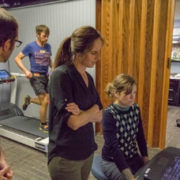by John Fiore, PT
Sapphire Physical Therapy
November is a good month to reflect on the past year. As runners, this season reminds us how important it is to be thankful for our experiences and challenges in 2017. In order to set realistic running goals for 2018, it is appropriate to look within for the driving force(s) for why we run.
Understanding the forces behind our motivation to succeed is a complex topic which is relevant to individuals and athletes of all ages and abilities. Our reasons to set and achieve goals are directly related to our past experiences, childhood upbringing, and the challenges we have faced along the way. Whether you are a world class athlete or recovering from a recent knee surgery, success depends on your ability to motivate yourself in the face of adversity. So why do some athletes push themselves to the level of extreme sports? Is it the success of crossing the finish line, or the struggles endured along the way? Consider the possible contributing factors below to better understand your unique reasons for pushing yourself to be healthier, stronger, faster, and more fulfilled as a person.
Personality Traits:
A March 7, 2016 article by Bradley Stulberg (Outside.com) described biological and personality traits shared by some world class athletes. Growing up in a goal-oriented household often leads to a goal-oriented adult. For some, the hard work required to reach an athletic goal fuels the fire to compete. Familiarity with struggle (both physical and/or emotional) at an early age may also motivate a person to challenge themselves through physical pursuits later in life. The road map of our life steers us over paths which may be a chaotic and rough as the ones we have left behind.
Biochemical Needs:
The feeling of well-being after achieving a goal is second to none. Our brain releases neurotransmitters such as Dopamine and Serotonin which provide us with a feeling of contentment and satisfaction associated with physical exercise. The brain depends on these neurotransmitters for health and balance of moods and our outlook on life. It is thought that the brains of extreme sport and ultra endurance athletes’ brains require more neurotransmitters to maintain homeostasis. This is often manifested in the frequency and intensity of one’s athletic goals. Once a goal has been achieved, a more challenging goal is established. In sports such as mountaineering, climbing, and ultra running, a more challenging goal implies a higher risk of injury or consequence. Balancing risk and success becomes a grey area for many athletes and must be factored into a healthy, long-term training plan.
Social Network:
Missoula is a prime example of a community held together by a love for the outdoors and endless recreational opportunities. The running, cycling, and skiing communities are vibrant in Missoula, providing a social network of camaraderie and support. Living by example is convenient in Missoula whether you are an aspiring athlete or a world class competitor.
Past Success and Failure:
For many athletes, standing on the podium is not the clearest memory, but rather the vulnerability experienced in failure. Whether failure was the result of poor training or an injury, the rawness of failure motivates like few other factors. Fear of failure, therefore, should not impact your ability to set a goal. Remember, failure can be a stronger predictor of future greatness than present or past success. Find your own motivational reasons and use them to fuel your passions in life. Through well planned goal setting, your unique personality needs can be met while allowing yourself to be present for your family, friends, loved ones, and even a stranger or two in need along the way.
John Fiore, PT
Sapphire Physical Therapy
1705 Bow Street
Missoula, MT 59801
www.sapphirept.com















